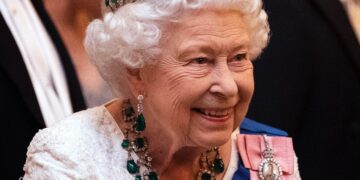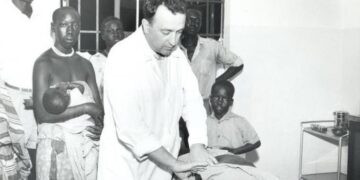Uganda profile
Uganda profile
THE official name of this nation is the Republic of Uganda. During colonial times when British Prime Minister Winston Churchill visited the territory which today is known as the Republic of Uganda, he described it as “The Pearl of Africa”.
Location
That description refers to the natural resources of Uganda, which include, but are not limited to mountains, green hills, fresh water bodies, forests, thousands of bird and animal species and largely picturesque countryside sceneries. Uganda, which spreads astride the Equator, thrives on generally fertile soils, with often regular rainfall in the seasons of March – May and September – November, except that lately, these have largely been affected by the global Climate Change.
The country boasts of a few mineral deposits of copper, cobalt, limestone, phosphate, and of most recent, oil as have been discovered in Hoima, one of the districts. Uganda has several inland lakes, rivers and swamps. About 12% of the country is land for national parks and game reserves. Forests are close to 70%, including woodland and grassland.
Uganda is a landlocked country bordered in the north by (now South) Sudan; in the east by Kenya; Tanzania in the South: and the Democratic Republic of Congo (formerly Zaire), in the east. Rwanda lies in the Southwest of Uganda. With its capital Kampala, Uganda covers an area of approximately 241,040sq. km. (93,070 sq. mi.). It is divided into 72 districts, at present, up from 39 at the time of promulgating the 1995 Constitution. There are, however, a number of applications to create more districts.
People and Religion
Uganda is a patchwork of ethnic groups. The 1995 Constitution of the Republic of Uganda provides for 56 indigenous communities, each of which speaks a unique language. English is, however, the country’s official language, while Luganda and Swahili are commonly used in day-to-day business, even though the two languages are neither national nor official. By 2006, it was estimated that there were approximately 28 million Ugandans in the country. Kampala City alone has a population of 1.2 million people. The majority of Ugandans are African, with a few people of Asian or European descent.
The Constitution also provides for freedom of religion and association. There are indeed several religious denominations in Uganda. Islam was the first of the exogenous religions to be brought into Uganda, when Arab traders moved inland from their enclaves along the Indian Ocean coast of East Africa and reached the interior of Uganda in the 1830s. But, it only got political significance in the 1970s, during the time of President Idi Amin. Christianity was introduced through the Buganda Region in the colonial times. It however, had lots of differences between Protestant Bangerezza (“the British”), who came a little earlier, and the Catholic Bafaransa (“the French”), who followed on the heels of the former. Protestant missionaries entered the country in 1877, followed by Catholic missionaries in 1879. In the early 1930s a breakaway group of Anglican missionaries together with several Ugandans initiated the Balokole (“Born Again/Pentecostals”) revival, which today has several different Pentecostal and Evangelical churches in and around the country. At 66% of the population, Christianity numbers highest, wherefore however, Catholics account for over 42% of all the population, according to the latest Census, 2002. Muslims make up 16%, while people following traditional and other beliefs are about 18%.
Agriculture is the main trade of the people of Uganda. It employs at little over 80% of the work force. There are many Ugandans qualified in different professions, who however, still get involved in agricultural projects for supplementary earnings. The most common crops in Uganda are coffee, cotton, beans, maize, sweet potatoes and bananas.
Political History
Uganda attained Independence on October 9, 1962. A member of the Commonwealth, the country was hitherto under British Rule for several years. During the count down to Independence, several Ugandan
personalities had established themselves in the political field. Among them was a celebrated lawyer and prominent Catholic Muganda, Benedicto Kiwanuka, leader of the Democratic Party (DP). He went on to become the Chief Minister of Pre-Independent Uganda after Britain granted the country internal self- government in 1961. At Independence, the Kabaka of Buganda, then Sir Frederick Muteesa II, became President, with a ceremonial role, against the exhortation of then Catholic Archbishop Joseph Kiwanuka, who argued that the Kabaka’s participation in politics would only be detrimental to the nation and the Kingdom in particular. This was after Muteesa’s largely Protestant/Buganda party, Kabaka Yekka (the King alone) allied with Apollo Milton Obote’s Uganda People’s Congress (UPC), also Protestant founded to outdo Kiwanuka’s Catholic DP. Obote became the first executive Prime Minister of Independent Uganda.
Muteesa’s tenure was cut short, when Obote in 1966, unleashed onto the olubiri (Kabaka’s Palace), a force led by Army Commander Idi Amin Dada, to overthrow the President. Obote went ahead to abrogate the 1962 Constitution and abolish monarchies. However, on January 25, 1971, Amin who had grasped the art, would overturn Obote’s government in a coup de tat, while the latter was in Singapore for a Commonwealth Summit. Amin ruled by decree for eight years until a combined force of Ugandan rebel exiles and some Tanzanian troops invaded from the South and overthrew the dictator on April 11, 1979. Immediately after, Prof. Yusuf Kironde Lule was sworn in as President, but only lasted for 67 days, before the army, the Uganda National Liberation Front (UNLF) replaced him with Godfrey Binaisa. This one ruled for no more than three months, when again the army pushed him and placed all authority in its chairman, Paulo Muwanga. He is remembered to have organized the contentious 1980 elections that brought Obote back to power and sent other leaders, including Yoweri Museveni and Andrew Lutakoome Kayiira into the bush to fight the regime.
In 1985, July 27, two disgruntled Acholi generals, Basilio Olara Okello and Tito Okello – commonly referred to as the Okellos – marched from Gulu to Kampala and overthrew Obote. The latter fled the country. The Okello’s Junta led by Tito, tried its hands at bringing peace, when the general signed a Peace Accord in Nairobi, with then advancing Museveni rebels, the National Resistance Army (NRA). But, on January 26, 1986, Museveni shot his way to presidency. He subsists as Head of State.
Government in Uganda
The NRA leadership brought several people of different political associations, in common collaboration under a broad based government. On July 12, 1995 after taking into account aspirations and views of the people, Uganda ratified its Constitution, which was promulgated on October 8, 1995. The document gives all power to the people of Uganda and makes the President Commander-in-Chief of the Armed Forces. It provides, for the first time in the history of the country, a Human Rights Commission and the office of the Inspector General of Government, two bodies which have bolstered governance, especially as regards the checks and balances of government (Executive, Legislature, Judiciary) excesses. The constitution restored monarchies, but hinders them from indulging actively in the politics. After 10 years, the Constitution was amended in 2005, and among other revisions, saw the 7th Parliament throw out the provision that had limited presidential 5-year terms to two. The terms are now open ended.
Today, Uganda is under a multiparty political dispensation. Its parliament, which is the 8th since independence, has 214 directly elected representatives. It also has 10 army representatives elected by officers of the Uganda Peoples Defence Force (UPDF); 72 women representatives elected in the districts; 4 youth representatives from the regions of the North, East, West and Central, plus 1 national youth representative; 5 representatives for workers; and 5 representatives for people with disabilities.
The president has powers to appoint ministers from among the members of Parliament. Once appointed, they do not lose their seats in Parliament, unless where such appointment is on the person of the speaker of parliament or the deputy speaker. Other Ugandans who are appointed ministers but are not elected members of parliament, automatically enter Parliament as ex-officio members. Vice President Prof. Gilbert Baalibaseka Bukenya, for example, is the Member of Parliament (MP) for Busiro North. However, Prime Minister Apollo Nsibambi is only an MP by virtue of his appointment as Premier.
Uganda’s main political parties, which also have representatives in the 8th Parliament are National Resistance Movement (NRM) with 259 members; the Forum for Democratic Change’s (FDC) 38 members, who are largely individuals that fell out with NRM; the Uganda People’s Congress (UPC) with 9; Democratic Party (DP) with 8; Conservative Party’s (CP) 1 member; and 1 for the Justice Forum (JEEMA). The 8th Parliament also has 16 MPs who contested on their own merit.
President Museveni has appointed virtually every judge on the bench today. The Constitution mandates Parliament to vet and approve the appointments. Currently, Hon. Justice Benjamin Odoki, is the Chief Justice and head of the Supreme Court of Uganda. His deputy, Hon. Lady Justice Laetitia Kikonyogo, the first Ugandan female lawyer, is also the first woman to hold a judicial office of such high level. She heads the Court of Appeal, which can also be constituted as the Constitutional Court. Justice James Ogoola, is the Principal Judge, and head of the High Court.
Economy
Although Uganda has had ample share of chronic political instability and erratic economic management, the country’s economy has great potential. It is considered the fastest growing economy in East Africa. Since 1986, government has taken pertinent measures towards economic recovery, including implantation of strategies to eradicate poverty. Among these is the Poverty Eradication Action Plan (PEAP), which encompasses programmes in the different sectors of the economy.
In 1987, Uganda’s inflation rate had reached a record 240%. However, this has reduced gradually over time. By June 1992 it had fallen to 42%; 5.4% in 1995-96 and only 5.1% by 2003. The Real Gross Domestic Product (GDP) at market price rates in the financial year 2005/2006 was 5.3%, which slightly went down from 6.6% in 2004/2005. The decrease was due to power shortages and a prolonged drought, which affected the agricultural sector. The manufacturing sector was also hit by power shortages.
The agricultural sector grew by only 0.4% (1.5% in 2004/5) and the service sector grew by 9.2% (8.7% in 2004/5). The average exchange rate depreciated by 6.8% from sh1,738 to US $1 in June 2005 to sh1,857 to US $1 in October 2005. On the whole, it remains relatively stable. Real GDP at market prices is projected to grow by over 5.9% in the financial year 2007/08. But the government is targeting a level of 7.0%.
Facts about Uganda
Government Republic
Capital City Kampala
Area 241.040sq.km
Population 28.8 million
Life expectancy 50.0 years
Literacy rate 66.8%
Currency Uganda Shillings
Languages English (official), Luganda, Swahili
Religions Roman Catholic, Protestant, Muslim, Indigenous beliefs
Fiscal July 1 – June 30
Year Agriculture: Coffee, Tea, Cotton, Tobacco, Sugarcane, Cut Flowers, Vanilla, Bananas, Maize, Cassava, Sweet Potatoes, Millet, Pulses, Beef, Goat meat, Pork, Milk, Nile Perch, Tilapia
Industry Processors of Agricultural Products (Cotton ginning, Coffee curing), Cement Production, Light Consumer Goods like Sugar, Beer, and Textiles
Exports Coffee, Fish and Fish products, Tea, Electricity, Horticultural products, Vanilla, Cut Flowers
Imports Machinery, Vehicles, Petroleum, Medical Supplies, Chemicals, Clothes
Natural Resources GDP: Copper, Cobalt, Limestone, Phosphate, Salt, Oil
GDP : Nominal: 2005/06 – US $9.4 billion
Links
www.state.gov/r/pa/ei/bgn/2963.htm
www.economywatch.com/world_economy/uganda/index.html
www.allafrica.com/stories/200604120749.html
www.pwc.com/Extweb/pwcpublications.nsf/
http://devdata.worldbank.org/external/CPProfile.asp?PTYPE=CP&CCODE=UGA












